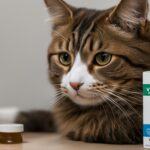As a pet owner, I know that the health of my cat is of utmost importance. One concerning issue that can arise is finding flea poop on my cat’s chin. Not only is it unsightly, but it can also indicate the presence of fleas and potential health risks. In this article, I will provide insightful perspectives on how to identify and address this problem, ensuring the well-being of your feline friend.
Flea dirt, also known as flea poop, is the waste left behind by fleas feeding on your cat’s blood. It can appear as tiny black specks or “dirt” on your cat’s chin. This is a clear sign that your cat has fleas and may require immediate attention.
Cat grooming plays a crucial role in preventing flea infestations and maintaining good cat chin health. Regular brushing and bathing can help remove fleas and their droppings, minimizing the risk of flea-related issues like cat chin acne. Additionally, keeping your cat’s living environment clean and vacuumed can further prevent flea infestations.
Understanding the importance of flea control in small animal practice is essential. Fleas not only cause discomfort but can also trigger allergic reactions and anemia in dogs, cats, and even humans. Fleas are also capable of transmitting various pathogens, making them a significant concern for both pets and their owners.
By addressing flea poop on your cat’s chin and implementing effective flea control measures, you can ensure the health and well-being of your beloved feline companion.
Key Takeaways:
- Flea poop on a cat’s chin can indicate the presence of fleas and the need for proper grooming and hygiene.
- Regular brushing and bathing can help remove fleas and prevent flea-related issues like cat chin acne.
- Fleas can cause discomfort, allergic reactions, anemia, and transmit various pathogens.
- Integrated flea control methods are crucial for preventing and managing infestations.
- Client education on realistic product expectations and comprehensive control strategies is essential for successful flea control.
The Importance of Fleas in Small Animal Practice
Fleas, such as Ctenocephalides felis, Ctenocephalides canis, and Pulex irritans, can cause significant issues in small animal practice. These tiny parasites are not only a nuisance but can also lead to allergic reactions, anemia, and transmission of various pathogens.
Allergic reactions to flea bites are a common problem, causing intense itching, skin irritation, and discomfort for pets. Some animals may even develop flea allergy dermatitis, a severe allergic reaction that requires immediate attention and treatment.
In addition to allergic reactions, fleas can also cause anemia in heavily infested animals. Fleas feed on blood, and a heavy flea burden can lead to significant blood loss, especially in small or weakened patients.

The Clinical Impact of Cardio-Respiratory Nematodes on Dogs and Cats
When it comes to the health of our beloved pets, it’s important to be aware of the various factors that can have an impact. One such factor is cardio-respiratory nematodes, parasites that can affect both dogs and cats. These nematodes, including Dirofilaria immitis, Angiostrongylus vasorum, Aelurostrongylus abstrusus, and Capillaria aerophila, can cause significant health problems for our furry friends.
Cardio-respiratory nematodes can lead to respiratory distress, cardiovascular issues, and other complications in dogs and cats. For example, Dirofilaria immitis, commonly known as heartworm, can cause severe damage to the heart and lungs of affected animals. Angiostrongylus vasorum, also known as lungworm, can result in respiratory problems and bleeding disorders. Aelurostrongylus abstrusus affects cats specifically, causing lung inflammation and respiratory distress. Capillaria aerophila, a tracheal worm, can also affect both dogs and cats, leading to coughing and difficulty breathing.
It is crucial for pet owners to be aware of these cardio-respiratory nematodes and the potential impact on their pets’ health. Regular veterinary check-ups and screening tests can help in early detection and prompt treatment. Preventive measures, such as deworming medications, can also be implemented to protect against the risk of infection. By staying informed and taking proactive measures, we can ensure the well-being and longevity of our beloved companions.
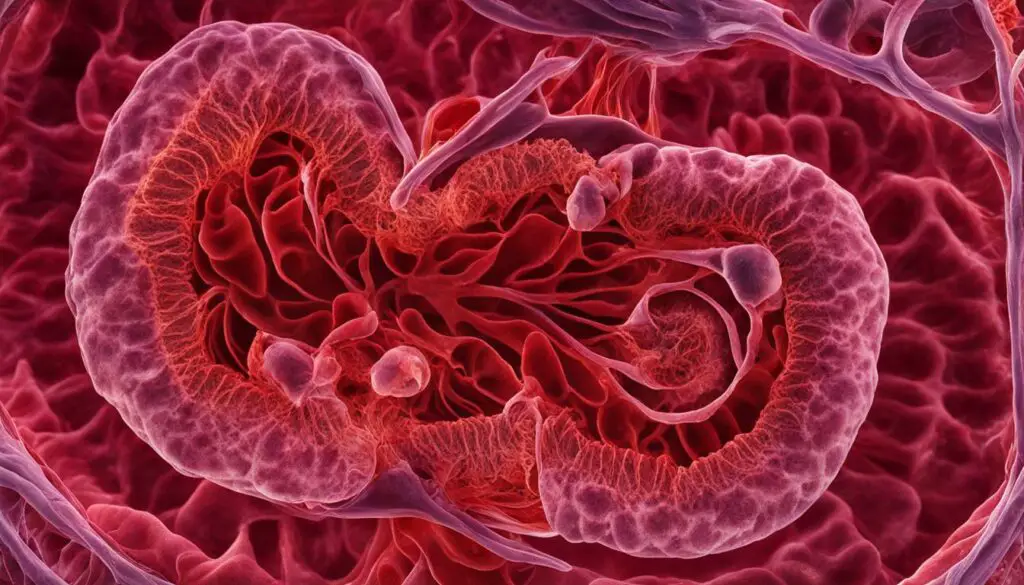
Table: Clinical Impact of Selected Cardio-Respiratory Nematodes on Dogs and Cats
| Nematode | Clinical Impact |
|---|---|
| Dirofilaria immitis | Severe damage to the heart and lungs |
| Angiostrongylus vasorum | Respiratory problems and bleeding disorders |
| Aelurostrongylus abstrusus | Lung inflammation and respiratory distress in cats |
| Capillaria aerophila | Coughing and difficulty breathing |
The Challenges of Flea Control in Changing Environments
When it comes to flea control, there are several challenges that arise in changing environments. Factors such as climate variations, host movements, and the emergence of new parasites can greatly impact the spread and clinical significance of fleas. As a result, it is crucial to understand and address these challenges in order to develop effective control methods that can adapt to the evolving landscape.
One of the primary challenges in flea control is the vectorial ability of fleas. Fleas have the capability to transmit diseases not only to animals but also to humans. Diseases like plague, caused by Yersinia pestis, and infections caused by Bartonella spp. are just a few examples of the dangers associated with fleas. It is important to recognize the potential health risks and take proactive measures to prevent and manage flea infestations.
Another challenge in flea control is the presence of emerging parasites. As the environment changes, new parasites can emerge and pose a threat to both animals and humans. Staying updated on the latest research and understanding the biology and behavior of these emerging parasites is essential for effective control strategies. By staying vigilant and proactive, we can minimize the impact of these parasites on our pets and ourselves.
| Challenges | Impact |
|---|---|
| Changing environments | Spread and clinical significance of fleas |
| Vectorial ability | Transmission of diseases |
| Emerging parasites | Threat to animals and humans |
“Flea control in changing environments requires a proactive and adaptive approach. By understanding the challenges associated with flea control, including the spread of fleas in changing environments, the vectorial ability of fleas, and the emergence of new parasites, we can develop effective strategies to protect our pets and ourselves.”
Flea Allergy Dermatitis: A Common Concern for Pets and Owners
Flea allergy dermatitis is a common problem that affects both pets and their owners. It occurs when a pet has an allergic reaction to the saliva of fleas. The condition is characterized by itching, scratching, and skin irritation, which can be distressing for the pet and concerning for their owner.
When a flea bites an allergic pet, the saliva triggers an immune response that results in intense itching. This leads to excessive scratching, causing further irritation and potential skin damage. Flea allergy dermatitis can affect any part of the pet’s body, but it is often observed on the lower back, tail base, hindquarters, and abdomen.
To manage flea allergy dermatitis, it is essential to implement effective flea control measures. This includes regular grooming and bathing to remove any fleas or flea dirt from the pet’s coat. Additionally, using flea control products such as spot-on treatments or flea collars can help prevent flea infestations and reduce the risk of allergic reactions.
| Symptoms of Flea Allergy Dermatitis | Prevention and Treatment |
|---|---|
|
|
If your pet is experiencing symptoms of flea allergy dermatitis, it is important to seek veterinary advice for proper diagnosis and treatment. Your veterinarian can recommend the most appropriate flea control products and provide guidance on managing the condition to ensure the comfort and well-being of your pet.

Quote:
“Flea allergy dermatitis can be a challenging condition to manage, but with proper flea control measures and veterinary guidance, it is possible to alleviate the discomfort and improve the quality of life for affected pets.” – Dr. Emily Johnson, DVM
The Role of Fleas in Vectoring Diseases
When it comes to vector-borne diseases, fleas play a significant role in transmitting infections to both animals and humans. Their vectorial ability allows them to transmit various pathogens and pose a risk to public health. Two notable diseases associated with fleas include plague and infections caused by Bartonella spp.
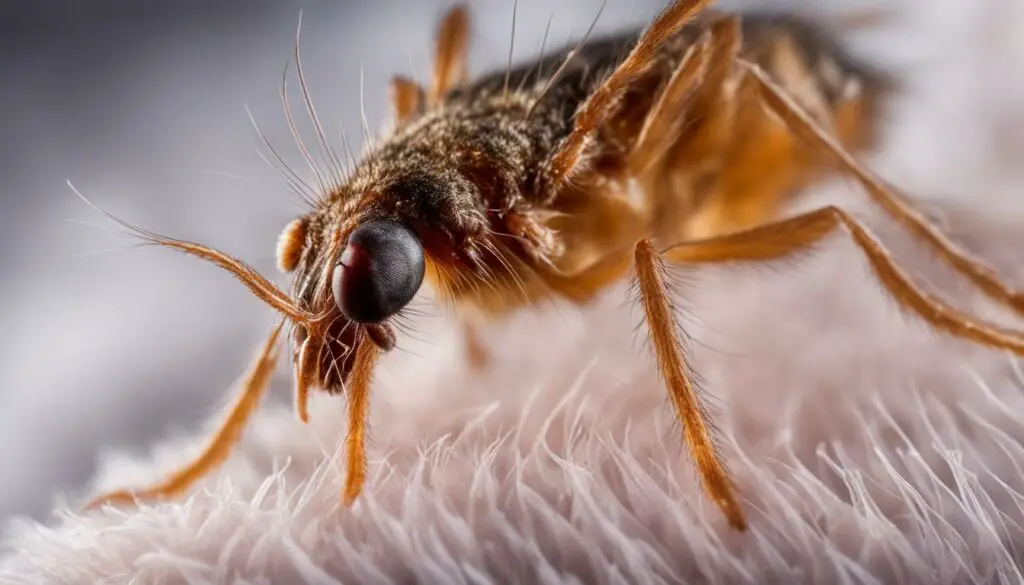
Plague, caused by the bacterium Yersinia pestis, is a severe and potentially deadly disease. Fleas, particularly the rat flea (Xenopsylla cheopis), are known to transmit this disease by biting infected animals and then subsequently biting humans. The transmission of plague by fleas has had a significant historical impact and has led to pandemics throughout history.
“Fleas have been responsible for some of the most devastating pandemics in human history, including the Black Death in the 14th century.”
In addition to plague, fleas are associated with the transmission of infections caused by Bartonella spp. These bacteria can cause a range of diseases in both animals and humans, including cat-scratch disease, trench fever, and bartonellosis. Fleas acquire the bacteria by feeding on infected hosts and can subsequently transmit the bacteria through their bites.
The Role of Dipylidium caninum
Another important parasite transmitted by fleas is the tapeworm Dipylidium caninum. This tapeworm primarily affects dogs and cats but can also infect humans. The life cycle of Dipylidium caninum involves fleas as intermediate hosts. When an animal ingests an infected flea during grooming, the tapeworm larvae develop into adult worms in the intestines.
It is crucial to recognize the vectorial ability of fleas in the transmission of diseases and take appropriate measures to prevent and control infestations. Flea control strategies should include regular pet grooming, proper hygiene practices, and the use of effective flea control products recommended by veterinarians.
| Diseases | Transmitted by Fleas |
|---|---|
| Plague | Yersinia pestis |
| Bartonella spp. infections | Bartonella spp. |
| Dipylidium caninum | Tapeworm |
Integrated Flea Control and the Prevention of Infestations
When it comes to flea control, taking an integrated approach is key to effectively preventing and managing infestations. This comprehensive strategy involves addressing both the pet and the environment to break the flea life cycle. By understanding the life cycle of fleas and implementing appropriate control measures, you can ensure the health and comfort of your furry friend.
To successfully control fleas, it is essential to treat both the pet and the premises. This means using appropriate flea control products on your pet and taking steps to eliminate flea eggs and larvae in the environment. By targeting all stages of the flea life cycle, you can disrupt their reproduction and greatly reduce the likelihood of infestations.
For pet owners, it’s important to regularly groom and inspect your pets for fleas. This includes using flea combs to remove adult fleas and checking for flea dirt (feces) on their chin, neck, and back areas. Additionally, keeping your home clean and vacuuming regularly can help remove flea eggs and larvae from the environment.
| Key Components of Integrated Flea Control | Benefits |
|---|---|
| Treating the pet with appropriate flea control products | – Kills adult fleas and prevents reinfestation – Stops the development of flea eggs and larvae |
| Eliminating premise infestations | – Removes flea eggs and larvae from the environment – Breaks the flea life cycle |
| Preventing the development of flea eggs and larvae | – Reduces the risk of future infestations – Maintains a flea-free environment |
By combining these approaches, you can effectively control fleas and prevent infestations from recurring. Remember to consult with your veterinarian for guidance on the best flea control products and methods for your specific pet’s needs. With proper integrated flea control, you can ensure a comfortable and flea-free environment for your beloved pet.
Understanding Product Expectations for Flea Control
When it comes to flea control, it’s important for pet owners to have realistic expectations about the products they use. Understanding the speed of kill and duration of activity of flea control products is crucial to ensure effective treatment and prevention. As a veterinarian, I often encounter clients who have misconceptions about how quickly and how long these products work.
Firstly, let’s talk about the speed of kill. Some clients expect that a flea control product will instantly eliminate all fleas on their pets. While these products are designed to start killing fleas within a certain timeframe, it’s important to note that it may take a few hours or even days for all the fleas to be eliminated. This is because flea control products work by targeting different stages of the flea life cycle, including eggs, larvae, and adult fleas, and it takes time for the product to take full effect.
Secondly, the duration of activity is an important factor to consider. Flea control products vary in their ability to provide long-lasting protection against reinfestation. Some products may provide protection for a few weeks, while others can last up to several months. It’s important for pet owners to follow the recommended application frequency and understand that regular reapplication may be necessary to maintain effective flea control.
| Product | Speed of Kill | Duration of Activity |
|---|---|---|
| Product A | Within 24 hours | Up to 1 month |
| Product B | Within 48 hours | Up to 3 months |
| Product C | Within 72 hours | Up to 6 months |
It’s important for pet owners to have realistic expectations about flea control products and understand that they may not provide instant results. Consistency and regular application are key to maintaining effective flea control.
As a veterinarian, I always recommend discussing flea control options with your veterinarian to find the best product for your pet’s needs. Your veterinarian can provide guidance on the most suitable product based on your pet’s health, lifestyle, and the severity of the flea infestation. By understanding the true speed of kill and duration of activity of flea control products, you can make informed decisions and ensure the health and comfort of your furry friend.
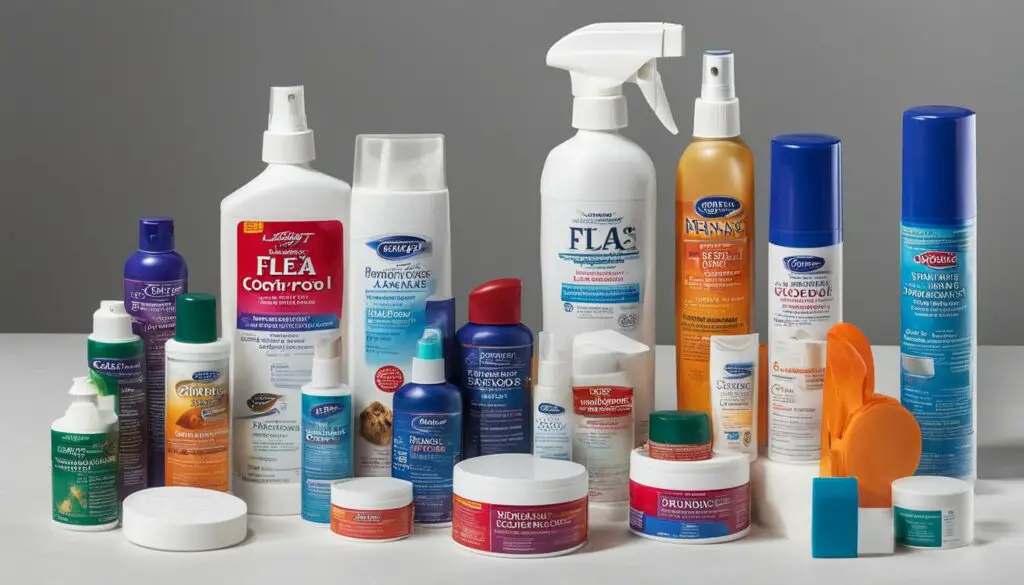
Addressing Persistent Flea Infestations and Client Factors
Persistent flea infestations can be a frustrating challenge for both pet owners and veterinary clinicians. To effectively address this problem, it is important to improve investigation skills and have a deeper understanding of the difficult flea challenges that can arise. By enhancing our knowledge and honing our diagnostic techniques, we can develop more targeted and successful treatment plans for our patients.
When it comes to persistent flea infestations, it is crucial to consider the factors that may be contributing to the problem. Client factors play a significant role in the success of flea control measures. Many pet owners may not fully understand the importance of consistent treatment, proper hygiene, and environmental control. Educating clients on these aspects and providing clear instructions can empower them to take an active role in flea prevention and management.
Client education is key in addressing persistent flea infestations. By explaining the life cycle of fleas, the importance of thorough grooming, and the need for regular veterinary check-ups, we can help pet owners make informed decisions about flea control. Additionally, we should emphasize the potential risks associated with untreated fleas, such as allergic reactions, skin infections, and the transmission of diseases. By fostering a collaborative approach with our clients, we can work together to overcome persistent flea infestations and ensure the well-being of their pets.
Investigation Skills and Client Education
When tackling persistent flea infestations, honing our investigation skills is crucial. It is important to take a comprehensive history, including details about the pet’s environment, any recent changes, and the efficacy of previous flea control measures. Performing a thorough physical examination, focusing on areas where fleas are commonly found, can also provide valuable insights.
Client education should be a central part of our approach. By explaining the importance of year-round flea prevention, regular grooming, and environmental control, we can help clients understand the role they play in preventing and managing infestations. This includes educating them about the risks associated with fleas and dispelling common misconceptions, such as the belief that indoor pets are immune to infestations. Clear instructions on proper product application, treatment frequency, and the importance of follow-up visits should also be provided.
Addressing persistent flea infestations requires a combination of improved investigation skills, client education, and targeted treatment plans. By working together with our clients and continuously expanding our knowledge, we can overcome the challenges posed by these persistent pests and ensure the health and happiness of our patients.

Break the Flea Life Cycle at the Host Level
Fleas are not only a nuisance to pets but also a potential threat to their health. To effectively control and eliminate flea infestations, it is essential to break the flea life cycle at the host level. This involves using specific products that target adult fleas and their eggs, preventing reproduction and further infestation.
Residual adulticides play a crucial role in flea control. These products are designed to kill adult fleas and provide long-lasting protection. By applying a residual adulticide to your pet, you can eliminate newly acquired fleas and prevent them from laying eggs in the environment.
Ovicidal products are another key component in breaking the flea life cycle. These products target flea eggs, rendering them nonviable and preventing them from hatching into larvae. By eliminating the eggs, you can significantly reduce the population of fleas in your home and prevent re-infestation.

Combining the use of residual adulticides and ovicidal products is crucial for effective flea control. By targeting both adult fleas and their eggs, you can disrupt the flea life cycle and achieve long-term protection for your pet.
Table: Comparison of Residual Adulticides and Ovicidal Products
| Product | Residual Adulticide | Ovicidal Activity |
|---|---|---|
| Product A | Yes | No |
| Product B | Yes | Yes |
| Product C | No | Yes |
As seen in the table above, Product B and Product C are both effective choices for breaking the flea life cycle. These products provide residual adulticide activity, killing adult fleas, and ovicidal activity, preventing egg hatchability. Choosing a product with both features can enhance the efficacy of flea control.
Remember, consistent and regular use of these products is crucial to ensure continuous protection for your pet. Consult with your veterinarian to determine the most suitable flea control products for your pet’s specific needs and follow the recommended application guidelines for optimal results.
Treating and Preventing Premise Infestations
Flea control is not just about treating pets; it also requires addressing the underlying cause of infestations – the premises where fleas reside and reproduce. An integrated approach that combines effective insecticides, proper application techniques, and the use of insect growth regulators is essential for long-term control. By targeting both adult fleas and their immature life stages, a comprehensive strategy can help eliminate infestations and prevent reinfestation.
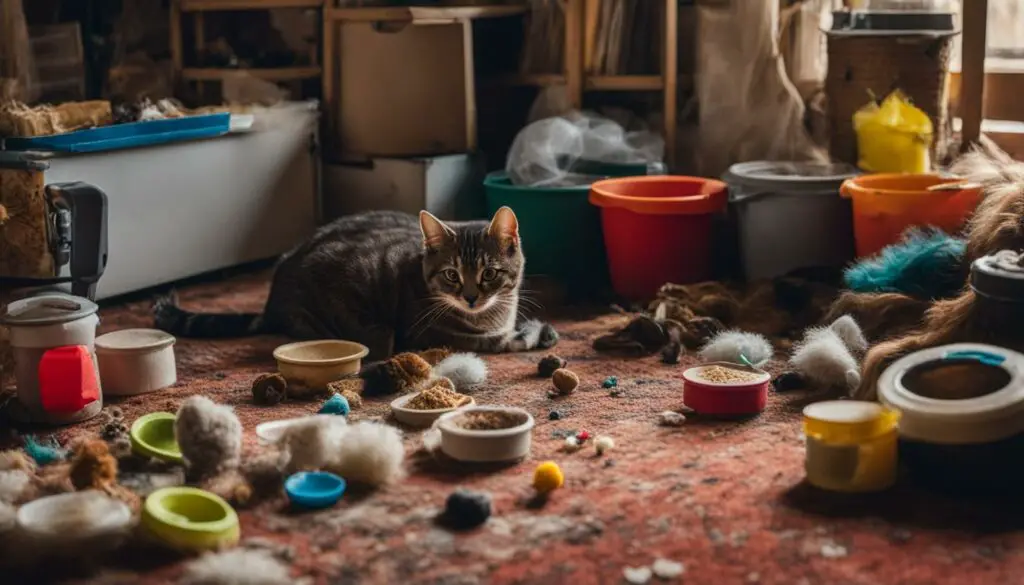
One of the key components of premise flea control is the use of insect growth regulators (IGRs). IGRs are chemicals that inhibit the development of flea eggs, larvae, and pupae, effectively breaking the life cycle of fleas. They can be applied as sprays, foggers, or in combination with other insecticides, depending on the extent of the infestation. IGRs provide long-lasting protection, preventing immature fleas from developing into adults and reducing the population over time.
An effective application of insecticides is crucial for treating premise infestations. It’s important to target areas where fleas are likely to be found, such as carpets, furniture, bedding, and cracks and crevices. Follow the instructions on the product label, ensuring proper dilution and coverage. Pay special attention to dark and humid areas where fleas tend to thrive. Vacuuming before treatment can help remove flea eggs and larvae, enhancing the effectiveness of the insecticides.
Table: Comparative Analysis of Insect Growth Regulators
| IGR | Mode of Action | Duration of Activity | Application Method |
|---|---|---|---|
| Methoprene | Disrupts flea development | 2-3 months | Spray, fogger, or spot-on |
| Precor | Inhibits flea growth | 4-6 months | Spray or fogger |
| Pyriproxyfen | Interferes with flea development | 3-5 months | Spray, fogger, or spot-on |
Effective hygiene practices are also essential in preventing and controlling premise infestations. Regular cleaning, washing bedding and pet accessories in hot water, and maintaining a clutter-free environment can help eliminate flea eggs, larvae, and pupae. It’s important to remember that fleas can survive in the environment for several weeks, so consistent efforts are necessary to ensure long-term control.
By adopting an integrated approach that incorporates insect growth regulators, proper application techniques, and good hygiene practices, pet owners can effectively treat and prevent premise infestations. Regular monitoring and follow-up treatments may be necessary, especially in high-risk areas or during peak flea seasons. Consultation with a veterinary professional can provide further guidance on the best strategies for managing premise infestations and safeguarding the health of your pets.
The Role of Client Education in Flea Control
Client education plays a vital role in effective flea control for pets. It is essential for pet owners to have a deep understanding of flea biology and epidemiology, as well as realistic product expectations. Educating clients about these important aspects can lead to better outcomes and improved satisfaction with flea control measures.
By providing comprehensive education on flea biology, pet owners can gain insights into the life cycle of fleas and understand the importance of treating both the pet and the environment. This knowledge empowers clients to take necessary actions to break the flea life cycle and prevent infestations.
Furthermore, realistic product expectations are crucial to ensuring client satisfaction and successful flea control. Pet owners need to be aware that flea control products may not provide immediate results and that consistent use is necessary for long-term efficacy. Educating clients about the speed of kill and duration of activity of different products allows them to make informed decisions about which products best suit their needs.
Client education also helps pet owners recognize the role they play in preventing and managing flea infestations. By understanding the importance of regular grooming, hygiene practices, and veterinary care, clients can actively contribute to their pet’s overall wellness and reduce the risk of flea-related health issues.
Key Recommendations for Client Education in Flea Control:
- Provide comprehensive information on flea biology, including the life cycle and habits of fleas.
- Explain the importance of treating both the pet and the environment to effectively control fleas.
- Set realistic expectations about the speed of kill and duration of activity of different flea control products.
- Emphasize the role of regular grooming, hygiene practices, and veterinary care in preventing flea infestations.
- Offer resources such as brochures, videos, or websites to reinforce client education on flea control.
By prioritizing client education in flea control, veterinary professionals can empower pet owners to take proactive measures in protecting their pets from the risks associated with fleas. Through a collaborative approach, veterinarians and pet owners can work together towards successful flea management and the overall well-being of the beloved feline companions.

Section 13: Conclusion
Flea control is essential for maintaining the health and well-being of your beloved feline companion. By taking an integrated approach that combines proper grooming, hygiene practices, and the use of effective flea control products, you can ensure that your cat stays happy and free from these pesky parasites.
Remember, flea control is not just about treating your cat; it also involves addressing premise infestations and breaking the flea life cycle at the host level. By treating and preventing infestations in your home environment, you can effectively control and eliminate fleas for the long term.
Education is key
To successfully combat fleas, it is crucial to educate yourself and your clients about flea biology, epidemiology, and realistic product expectations. Understanding how fleas reproduce, spread, and cause discomfort will empower you to make informed decisions and implement comprehensive control strategies.
In conclusion, by prioritizing flea control as an integral part of your pet care routine, you are ensuring the overall health and happiness of your cat. With an integrated approach that includes grooming, hygiene, and effective flea control methods, you can keep your feline friend safe and free from the burdens of flea infestations.
FAQ
What does flea poop on a cat’s chin indicate?
Flea poop on a cat’s chin can indicate the presence of fleas and the need for proper grooming and hygiene.
What are some common issues caused by fleas?
Fleas can cause discomfort, allergic reactions, and anemia in dogs, cats, and humans. They can also transmit various pathogens.
What are cardio-respiratory nematodes and what impact do they have on dogs and cats?
Cardio-respiratory nematodes, such as Dirofilaria immitis and Angiostrongylus vasorum, can cause respiratory distress and cardiovascular issues in dogs and cats.
What are the challenges of flea control in changing environments?
Flea control can be challenging in changing environments due to factors like climate, host movements, and the emergence of parasites, which can impact the spread and clinical significance of fleas.
What is flea allergy dermatitis and how can it be managed?
Flea allergy dermatitis is a condition characterized by itching, scratching, and skin irritation caused by an allergic reaction to flea saliva. It can be managed through proper flea control, grooming, and regular veterinary care.
Can fleas transmit diseases to animals and humans?
Yes, fleas have vectorial ability and can transmit diseases like plague and infections caused by Bartonella spp. They also play a role in the transmission of the tapeworm Dipylidium caninum.
What is integrated flea control and why is it important?
Integrated flea control involves a combination of strategies to treat the pet, eliminate premise infestations, and prevent the development of flea eggs and larvae. It is important for preventing and managing infestations.
How can client expectations regarding flea control products be managed?
It is important to educate clients on the true speed of kill and duration of activity of flea control products in order to set realistic expectations.
How can persistent flea infestations be addressed?
Veterinary clinicians need to improve their investigation skills and understand client factors that contribute to persistent infestations. Educating clients on proper flea control measures is also important.
How can the flea life cycle be broken at the host level?
The flea life cycle can be broken at the host level by using residual adulticides that kill newly acquired fleas and ovicidal products that render flea eggs nonviable, thus preventing reproduction.
What is the importance of treating and preventing premise infestations?
Treating and preventing premise infestations is crucial for long-term flea control. An integrated approach using insect growth regulators, proper application of insecticides, and good hygiene practices can help eliminate immature flea life stages in the environment.
What role does client education play in flea control?
Client education is vital in flea control. By educating clients about flea biology, epidemiology, and the importance of comprehensive control strategies, better outcomes can be achieved.
How can flea control ensure the well-being of cats?
By taking an integrated approach that includes proper grooming, hygiene practices, and the use of effective flea control products, pet owners can ensure the well-being of their feline companions.






